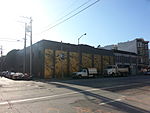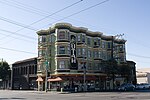San Francisco 4th and King Street station
1975 establishments in CaliforniaCaltrain stations in San FranciscoFormer Southern Pacific Railroad stations in CaliforniaMuni Metro stationsProposed California High-Speed Rail stations ... and 4 more
Railway stations in the United States opened in 1975San Francisco Municipal Railway streetcar stationsSouth of Market, San FranciscoUse mdy dates from October 2022

San Francisco 4th and King Street station (previously 4th & Townsend), or Caltrain Depot is a train station in the SoMa district of San Francisco, California. It is presently the northern terminus of the Caltrain commuter rail line serving the San Francisco Peninsula and Santa Clara Valley. It is also the eastern terminus of the N Judah and E Embarcadero, as well as a stop along the T Third Street of the Muni network. The station is additionally the projected terminus for the first phase of the California High-Speed Rail project and a station once Phase 2 is completed.
Excerpt from the Wikipedia article San Francisco 4th and King Street station (License: CC BY-SA 3.0, Authors, Images).San Francisco 4th and King Street station
King Street, San Francisco
Geographical coordinates (GPS) Address Nearby Places Show on map
Geographical coordinates (GPS)
| Latitude | Longitude |
|---|---|
| N 37.776388888889 ° | E -122.39444444444 ° |
Address
Bay Wheels
King Street
94158 San Francisco
California, United States
Open on Google Maps






